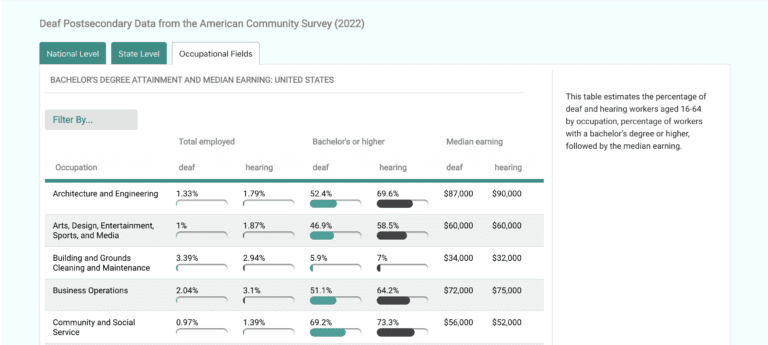NDC's Data Dashboard

In 2021, 1.9% of people in the United States are deaf – learn more about the educational and employment experiences of deaf people by exploring our interactive data dashboard! National and state level data are available.
Deaf Youth Report: What Does the Data Tell Us?
Deaf young people in the United States who are between the age of 16 and 24 are a highly diverse group – while some of them are still in high school, many are working or continuing their education. However, more deaf youth are not working or going to school, compared to hearing people in the same age group. This is an opportunity to improve systems of support so more deaf youth have equitable access in school and the workplace.
Deaf College Student Data & Research Findings
Research consistently underscores the positive impact of higher education on the lives of deaf people. Deaf people who have earned a college degree earn more money, have higher employment rates, and are more likely to be involved in their communities.
Supporting Deaf College Students: Perspectives From Disability Services Professionals
We asked detailed questions to Disability Services Professionals about the support deaf students receive in college and added new questions about how these services connect with students’ identities. Their perspectives help to enrich the understanding of barriers on campus that deaf students may experience and help identify areas of needed improvement.
Latest Research
Community-Led Research

Get Strategies for Deaf-Led System Change with New Resource
Decisions are made every day about deaf people’s lives without involving deaf people. This needs to change. The lived experience and knowledge of deaf community members must guide policy changes, strategic planning, and programs that are designed to reduce barriers and increase opportunities for deaf people in the United States.
New NDC Report

Deaf Youth: What Does the Data Tell Us?
Deaf young people in the United States who are between the age of 16 and 24 are a highly diverse group – while some of them are still in high school, many are working or continuing their education.
Data Spotlight

Employment and Education in the Rural Deaf Landscape
Rural areas boast beautiful open spaces and close-knit communities, but they also come with big challenges, especially for deaf people. A new report from NDC—“Rural Deaf Experiences: Employment and Educational Attainment Data”—shows that deaf people in rural areas face more obstacles than those in cities. They have fewer available job
ONLINE LEARNING MODULE
Discovering System Barriers and Exploring the WHY
This is a one-hour self-paced learning module that helps you explore factors that influence postsecondary outcomes for people who are deaf. Understanding root causes is an important step for moving beyond temporary solutions to address systemic causes of educational inequities for deaf people.





